Water Quality and Heavy Metals Distribution in Surface Water of the Kelantan River Basin (Malaysia)
Yet Yin Hee*, Suhaimi Suratman and Azyyati Abdul Aziz
Institute of Oceanography and Environment, Universiti Malaysia Terengganu, 21030 Kuala Nerus, Terengganu, Malaysia.
Corresponding Author E-mail: yueyen_yy@hotmail.com
DOI : http://dx.doi.org/10.13005/ojc/350402
Article Received on : 27-06-2019
Article Accepted on : 11-07-2019
Article Published : 26 Jul 2019
This paper explores the water quality status of the Kelantan River from the middle to lower reaches of the basin, during the dry and wet seasons, in order to provide a scientific reference for protecting local aquatic environments and managing river basin development in the future. Although research shows that this river basin is fell in Class I under Malaysian National Water Quality Standard in term of heavy metals, the river was overall classified as slightly polluted, based on the Malaysian Department of Environment-Water Quality Index (DOE-WQI), with total suspended solids (up to 291 mg/L) reaching the allowable threshold limit established by DOE. Field data suggests that the decomposition of organic matter could have resulted in lowering the dissolved oxygen levels in the water column. With regards to heavy metals, it was found that they mainly originated from natural sources, but with an increasing level of contribution from anthropogenic activities.
KEYWORDS:Distribution; Heavy Metals; Kelantan River Basin (Malaysia); National Water Quality Standard; Surface Water
Download this article as:| Copy the following to cite this article: Hee Y. Y, Suratman S, Aziz A. A. Water Quality and Heavy Metals Distribution in Surface Water of the Kelantan River Basin (Malaysia). Orient J Chem 2019;35(4). |
| Copy the following to cite this URL: Hee Y. Y, Suratman S, Aziz A. A. Water Quality and Heavy Metals Distribution in Surface Water of the Kelantan River Basin (Malaysia). Orient J Chem 2019;35(4). Available from: https://bit.ly/2M9Q4Uq |
Introduction
The Kelantan River basin is situated in the Kelantan state, facing the South China Sea, on the east coast of Peninsular Malaysia. This river is the second largest river in Peninsular Malaysia, covering the entire Kelantan state and flowing into the South China Sea through the capital city of Kota Bharu. As the main river in Kelantan state, it plays a vital role in sustaining the population of about 0.5 million inhabitants of the Kelantan basin, suppling most of their water for drinking, agriculture, plantation irrigation, small scale fishing industries, sand mining activities, and also providing a means of transport and a means of receiving wastewater treatment effluents. The river network therefore plays an important underpinning role to support both, the local and the Malaysian economy. However, the Kelantan River basin faces growing pressures from a rapidly increasing population and water usage,1 which is likely to increase pollution loadings and water stress in future decades.
Monitoring of the river waters has been conducted regularly by the Malaysian Department of Environment (DOE) based on the Water Quality Index (WQI) and Malaysian National Water Quality Standard (NWQS), in order to achieve good quality river water and protect designated uses of rivers (Table 1). The WQI serves as a basis for environmental assessment of a watercourse, in relation to pollution load categorization and designation of classes of beneficial uses as provided under the NWQS. In WQI, there are six parameters, which are, Dissolved Oxygen (DO), pH, Biological Oxygen Demand (BOD), Chemical Oxygen Demand (COD), Total Suspended Solids (TSS) and Ammoniacal Nitrogen (AN). These were chosen as primary parameters to indicate the level of pollution and ecosystem health of the river. As mentioned by Huang et al.,2 the major issues in Malaysia’s rivers are BOD, AN and suspended solids that are caused mainly by untreated/partially treated sewage from manufacturing and agro-based industries, domestic sewage and livestock farming. The Kelantan River is also considered slightly polluted in terms of BOD3 and TSS,4 and has shown a certain level of heavy metal pollution in recent years.4-6
Table 1: National Water Quality Standards for Malaysia.
| Parameter | Unit | Class | ||||
| I | IIA/IIB | III# | IV | V | ||
| pH | 6.5-8.5 | 6-9 | 5-9 | 5-9 | – | |
| DO | mg/L | 7 | 5-7 | 3-5 | <3 | <1 |
| BOD | mg/L | 1 | 3 | 6 | 12 | >12 |
| COD | mg/L | 10 | 25 | 50 | 100 | >100 |
| TSS | mg/L | 25 | 50 | 150 | 300 | 300 |
| AN | mg/L | 0.1 | 0.3 | 0.9 | 2.7 | >2.7 |
| Cd | mg/L | Natural Level orAbsent | 0.01 | 0.01* (0.001) | 0.01 | Level above IV |
| Cu | mg/L | Natural Level orAbsent | 0.02 | – | – | Level above IV |
| Pb | mg/L | Natural Level orAbsent | 0.05 | 0.02* (0.01) | 5 | Level above IV |
| Fe | mg/L | Natural Level orAbsent | 1 | 1 | 5 | Level above IV |
| Zn | mg/L | Natural Level orAbsent | 5 | 0.4* | 2 | Level above IV |
* = At hardness 50 mg/L CaCO3
# = Maximum (unbracketed) and 24-hour average (bracketed) concentrations
Class I Conservation of natural environment
Water supply I – Practically no treatment necessary
Fishery I – Very sensitive aquatic species
Class IIA Water supply II – Conventional treatment required
Fishery II – Sensitive aquatic species
Class IIB Recreational use with body contact
Class III Water supply III – Extensive treatment required
Fishery III – Common of economic value and tolerant species; livestock drinking
Class IV Irrigation
Class V None of the above.
Heavy metals are known to be toxic, persistent within environmental settings, possibly bioaccumulated and concentrated in the biota and food chain, as well as containing carcinogenic metalloids.7–9 There are various sources, including natural and anthropogenic, of heavy metals in aquatic environments. Metals from anthropogenic sources such as industrial wastes, agricultural runoff, urban runoff, atmospheric deposition, and automobile emissions could be dispersed to the surface water via surface runoff or rain water.7,9 In Malaysia, most of the water quality evaluations, such as heavy metals, only measure the concentration of dissolved forms. However, when heavy metals enter and get transported along the rivers, they may get adsorbed to suspended particles in the water column or undergo numerous changes in their speciation due to dissolution, precipitation and complexation.10-12 Hence, information on dissolved metal concentrations is not sufficient for the assessment of the environmental impact of river water contamination. Moreover, although the river water quality is monitored by DOE, there is still a lack of current data along the Kelantan River basin concerning the origins of inputs and spatial distributions, as well as missing data for several months in a year, leading to uncertain temporal patterns of river water quality and heavy metals.
Therefore, the main objectives of this study are, to assess the water quality of the Kelantan River basin, as well as to study the concentration and distribution of dissolved and particulate metals across this river in relation to the source, to look for seasonal changes of their distributions, and to assess the water quality status by using WQI and NWQS as indicators. Through the results of this study, we hope to provide a scientific reference for protecting local aquatic environments and managing river basin development in the future.
Materials and Methods
This study took place in the Kelantan River basin (Fig. 1) which is located at the east coast of Peninsular Malaysia (longitude 101°20’ to 102°20’N and latitude 4°40’ to 6°12’E). The river is subjected to dry (April-September) and wet (October-March) seasonal influences. The wet season typically brings heavy rainfall of up to 1750 mm over the whole season to this region, with a higher river flow (up to 1186 m3 s-1) obtained in this season.13–15
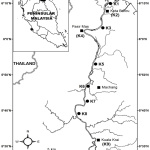 |
Figure 1: Sampling stations in the Kelantan River basin, Kelantan. |
Water samples were collected at monthly intervals at nine points (K1, K2, K3, K4, K5, K6, K7, K8, K9) along its length, extending from the middle to lower reaches of the main Kelantan River. Sites were selected to be easily accessible by road. Due to the long distance between upstream and downstream, the upstream of the Kelantan River was not covered in this sampling programme. Stations K8 and K9 are located in the middle reaches of the Kelantan River, while stations K1, K2 and K3 are downstream stations. The rest of the stations (stations K4, K5, K6 and K7) are in the middle reaches of the sampling site in this study. By conducting the sample collection at different points from middle to lower reaches of Kelantan River, the effect of land use activities on the water quality and heavy metals concentration in the water column can be investigated accurately. The monthly sampling programme began at the beginning of August 2010 and lasted until the beginning of November 2010, covering both the dry and wet seasons in this time frame.
In the field, surface water samples for TSS, AN and heavy metal analysis were collected directly by immersing the 1 L high density polyethylene (HDPE) bottle n the surface water; while for BOD5 analysis, water samples were collected in the BOD bottles and closed without any bubble trapping. The pre-cleaned HDPE bottles were rinsed with a sample prior filling, to minimize cross contamination. All bottles were HCl acid-washed (except HNO3 used for heavy metals analysis), rinsed with deionized (DI) water and dried prior to use. pH and DO were measured in the field using a calibrated YSI multiparameter ata logger (model 6600). Water samples were stored in an icebox and transported while chilled until returned to the laboratory.
The water samples used for water quality and heavy metal analyses were based on the Standard Method for Examination of Water and Wastewater.16 On returning to the laboratory, DO concentrations for BOD5 values were measured using desktop DO meter, and BOD5 was calculated by quantifying the DO of samples before and after the 5-day incubation at 20°C. COD was measured by the open efflux method. For TSS, a known volume of water sample was filtered through the membrane filter, followed by drying the filter in an oven at 105°C and weighing until filter weight remained constant.
Samples for AN and metal analyses were vacuum filtered through a 0.45 μm pore size cellulose acetate membrane filter, and this filtration process for metals was performed in a class 100 laminar flow. AN was then analyzed using an indophenol method by a Shidmazu UV-vis Spectrophotometer Cary-50. For particulate metals, 100 mL of water sample was filtered through the membrane filter, and the filter containing suspended particulate material was kept for later analysis, while the filtrate for dissolved metal analysis was acidified to pH <2 with 2 mL of concentrated HNO3.
For particulate metal analysis, the Teflon bomb acid digestion was chosen as the pre-concentration method. The filtered suspended particulate on the membrane filter was mixed with a mixture of HNO3-HCl-HF (3:3:1) in a vessel Teflon. The digestion process was then carried out in an oven at 100°C for 7 hours, followed by overnight cooling. After cooling, the digested solution was diluted with DI water in the presence of boric acid, in order to remove the excess HF. Particulate metal concentrations were lastly analyzed by inductively coupled plasma optical emission spectroscopy (ICP-OES) model Varian (Vista Pro). On the other hand, the filtrate samples for dissolved metal analysis were extracted, pre-concentrated and matrix removed using 5 mL of ammonium pyrollidine dithiocarbamate into 10 mL of methyl isobutyl ketone (APDC-MIBK) chelation-solvent extraction method. Lastly, the concentrations of the dissolved metals were determined using a Varian Graphite Furnace Atomic Absorption Spectrophotometry (GFAAS).
Results
In general, water quality parameters varied considerably from the middle to lower reaches of the river basin in terms of average (Fig. 2). Overall, the river waters had an average DO range of 4.93 mg/L – 6.37 mg/L across the Kelantan River. Seasonally, average DO levels were higher in August and September (dry season), but lower in October and November (wet season) (Fig. 3). TSS followed a similar seasonal trend, with higher mean concentrations occurring in the wet season as opposed to the dry season. Spatially, average TSS concentrations were between 211 mg/L – 291 mg/L, with higher concentrations observed at the stations that were mostly downstream (station K1) and close to city (station K8). In contrast, average BOD5 concentrations during August and September were lower than those in October and November. The average range of BOD5 concentration varied from 0.29 mg/L to 1.91 mg/L. The average concentrations of COD and AN were in the ranges 10.85 mg/L – 43.08 mg/L and 0.15 mg/L – 0.32 mg/L, respectively. Although COD and AN did not show a clear seasonal trend, the highest average concentrations of these parameters were found in the wet season. In terms of spatial comparison, average concentrations of COD at the middle reach of the Kelantan River were overall higher than those at the downstream stations; while AN concentration was higher at station K7 and downstream stations. Water pH across the Kelantan River was not changing much during the sampling period. On average, it ranged between 5.37 and 5.85.
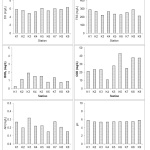 |
Figure 2: Spatial variation of DO, BOD, COD, AN, TSS and pH in the Kelantan River basin. |
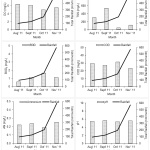 |
Figure 3: Monthly variation of mean DO, BOD, COD, AN, TSS and pH with respective to total monthly rainfall. |
Fig. 4 and Fig. 5 show the histograms based on monthly variation and spatial variation of mean dissolved metals (Cd, Zn, Cu, Fe and Pb) of the nine stations during the four times of sampling in the Kelantan River, respectively. The mean concentrations of dissolved metals ranged between 0.45 μg/L – 0.81 μg/L for Cd, 35.33 μg/L – 46.12 μg/L for Zn, 0.10 μg/L – 0.21 μg/L for Cu, 12.37 μg/L – 22.69 μg/L for Fe, and 0.84 μg/L – 1.70 μg/L for Pb, respectively, across the nine stations. With the exception of dissolved Zn, most of the dissolved metals were clearly recorded as having higher mean concentrations in the dry season than those in the wet season, showing an opposite seasonal trend with the rainfall pattern. However, the highest mean concentration of dissolved Zn among the four samplings remained in the dry season i.e. August. Spatially, the dissolved metal concentrations were higher at the town of Kuala Krai (station K9). Another instance of higher dissolved metal concentration occurred at station K6, where sand mining activity occurred. It was found that the heavy metal contents had generally peaked after the river flowed into the lowland plain (station K3, also an active sand mining activity station) from the mountainous area (station K4), but had decreased towards the estuary area.
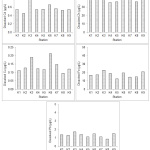 |
Figure 4: Spatial variation of dissolved metals in the Kelantan River basin. |
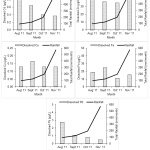 |
Figure 5: Monthly variation of mean dissolved metals with respective to total monthly rainfall. |
The spatial and monthly variations of mean particulate metal concentrations in the Kelantan River are presented in Fig. 6 and Fig. 7, respectively. Across the river, the concentrations of particulate metals were 12.15 μg/L – 15.06 μg/L for Cd, 3.20 μg/L – 4.08 μg/L for Zn, 34.90 μg/L – 51.17 μg/L for Cu, 58.38 μg/L – 106.39 μg/L for Pb, and 41.45 μg/L – 60.94 μg/L for Fe, respectively. Following their dissolved forms, particulate metals were generally having a similar but not identical spatial trend, where higher concentrations were recorded at stations K3 and K6. Seasonally, concentrations of particulate metals were not overall higher in the dry season. However, majority of them (Zn, Fe and Pb) still peaked in this season.
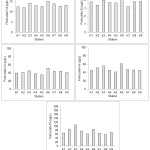 |
Figure 6: Spatial variation of particulate metals in the Kelantan River basin. |
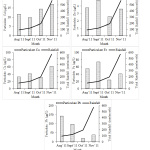 |
Figure 7: Monthly variation of mean particulate metals with respective to total monthly rainfall. |
Discussion
The DO values were relatively low at those stations (i.e. stations K3 and K6) where higher concentrations of BOD5 and COD were recorded, implying that the organic wastes cause depletion of DO in the water column, due to the consumption of oxygen by the decomposition of organic materials.4,17 Meanwhile, station K9, which was located at the middle reach of the river after two small tributaries joined into the main river channel, had recorded a higher DO concentration, which was probably due to its location at the upper stream of the river as well as higher flow, causing mixing processes from two tributaries. Although mixing and organic decomposition processes were likely the main controllers of DO levels in the Kelantan River, organic decomposition processes showed a greater influence on seasonal DO level changes, seeing that the lowest DO value was found during the highest BOD5 and COD levels in October, while the rainfall and river flow were also increased in this month. On the other hand, previous studies of the rivers on the east coast of Peninsular Malaysia have found that the TSS concentrations had peaked during periods of the heavy raining season.18,19 During the heavy raining season and hence during high flow, a combination of soil erosion inputs and re-suspended bed sediments within the river, could increase the suspended solids in the water column.19,20 However, the higher TSS concentration in the Kelantan River, which was reported by Yen and Rohasliney4 at the similar location as in this study during the wet season, due to the floating fine slit carried by rainwater to the river, was not observed in this study, probably due to the dilution effect in this current study. Therefore, more extensive studies, especially during the wet season, are needed to confirm on whether dilution or enhancement effect has a bearing on the TSS amount in the Kelantan River.
Heavy metals in the Kelantan River were predominantly in particulate form, indicating that there were major inputs of particulate-bound heavy metals from the river channel to the water column. The Kelantan River is known to be polluted by suspended solids since 1990s, mainly due to the logging activities upstream and sand mining activities along the river.4,21,22 Vegetation cutting, rainforest degradation and sand mining activities have previously been found to result in a serious erosion of soil and weathering of sedimentary rocks rich in heavy metals, which were then input into the river.4,23 Across the river, particulate metals were higher at the stations closed to sand mining activity areas (stations K3 and K6). Meanwhile, TSS pollution can also be observed in this current study, which would mean that the concentration in the river has reached the allowable threshold limit of the DOE-WQI. Therefore, higher particulate metals in this study were likely associated with higher TSS in the Kelantan River, due to sand mining activity Fig. 8).
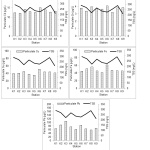 |
Figure 8: Spatial variation of particulate metals with respective TSS in the Kelantan River basin. |
With regards to higher dissolved metals at station K3, which was located at a lowland plain after the mountainous area, and was close to sand mining activity, it can be inferred that the dissolved metals in this station could have originated from the natural weathering materials6 and could have also been influenced by the sand mining activity.22 In a previous study of heavy metals in the Kelantan River that was carried out in 1993, Ahmad et al.5 reported that the heavy metals of Kelantan River were derived from natural weathering and erosion materials in the upstream river basin, with no anthropogenic input. However, Wang et al.6 in their recent study of heavy metals in the Kelantan River had reported that Pb was slightly enriched in sediments and that the enrichment level relatively higher in river channel than estuarine inter-tidal flat and adjacent shelf sea. Wannahari et al.23 reported that the discharge of industrial wastewater into the Kelantan River estuary had resulted in excessive levels of Pb in the coastal waters. Although the influence of industrial discharge on heavy metals in Kelantan River was not directly investigated in this study, with the prevalence of extensive sand mining activity and industrial development along the Kelantan River, the dissolved metals in this study could probably derived from anthropogenic activities in addition to natural sources.
According to the DOE NWQS for Malaysian rivers, average values of DO, BOD5 and AN in the Kelantan River were categorized under class II, while pH and COD fell into class III. These parameters are considered to be in the permissible limits. However, TSS mean concentration during the study period reached the allowable threshold limit and was classified under class IV. Using six of these parameters, DOE-WQI is calculated and provides a single number that expresses the overall water quality of a river. This is useful in providing a simple indicator of river water quality and defines its respective beneficial uses. Based on the calculation, the Kelantan River has an average WQI of 74.41, which falls into Class III. According to the DOE Water Quality classification, Kelantan River is considered to be slightly polluted and only tolerant species would be able to survive in this river’s waters. Under this category, Kelantan River is said to be only suitable for livestock drinking and would require extensive treatment for the river water to be able to act as water supply.
In terms of heavy metals, only dissolved forms are listed in NWQS as water quality references. Therefore, no comparisons can be made for particulate metals to determine the suitability of the water body to its users in the Kelantan River. Unlike the six water quality parameters above, levels of dissolved trace metals in Kelantan River were generally low and within the ranges of Class I based on the NWQS classification, although they varied spatially across the river during the study period. Under this category, the Kelantan River is considered at the natural background level. Therefore, water supplied from this river requires practically no treatment and is suitable for conservation of aquatic species with respect to metals.
Conclusion
Although the Kelantan River is found to have received minimum anthropogenic metals and fell in Class I under NWQS in term of heavy metals, this river still suffers with TSS pollution and was considered slightly polluted under DOE-WQI. However, the results are based on the short term samplings due to limited facilities and budget. In order, to provide a good scientific data for future comparison, it is suggested more sampling should be carried to cover the wet and dry seasons. In addition, since there is a potential of continuous social-economic development and population increase in the Kelantan state, continuous monitoring and comprehensive sampling are necessary to be carried out in the Kelantan River to capture the impact of increasing population densities, land-use changes and social-economic development to the river, which has important implications for the sustainability of Kelantan and Malaysian economy.
Acknowledgements
This study was partially supported by the Ministry of Education, Malaysia (Fundamental Research Grant Vote No. 59313) and the Higher Institution Centre of Excellence (HICoE), Research Grant (Vote No. 66928). The assistance of Nelson Chear Jeng Yeow and Thulasi A/P Selvaraja in the sampling and analysis is kindly acknowledged.
Conflicts of Interest
The authors declare that there are no conflicts of interest with any person and organization related to this article.
References
- Adnan, N. A.; Atkinson, P. M.; Exploring the impact of climate and land use changes on streamflow trends in a monsoon catchment. International Journal of Climatology, 2011, 31, 815–831.
- Huang, Y. F.; Ang, S. Y.; Lee, K. M.; Lee, T. S.; Quality of water resources in Malaysia. In InTech 2015. Available at https://api.intechopen.com/chapter/pdf-download/47539. Accessed in May 2019.
- Department of Environment (DOE). River Water Quality. In Malaysia environmental quality report 2015. Available at https://enviro.doe.gov.my/ekmc/wp-content/uploads/2016/09/4-EQR-2015-Bab-3-1.pdf. Accessed in May 2019.
- Yen, T. P.; Rohasliney, H.; Status of water quality subject to sand mining in the Kelantan River, Kelantan. Tropical Life Sciences Research, 2013, 24, 19–34.
- Ahmad, A. K.; Mushrifah, I.; Shuhaimi-Othman, M.; Water quality and heavy metal concentrations in sediment of Sungai Kelantan, Kelantan, Malaysia: A baseline study. Sains Malaysiana, 2009, 38, 435–442.
- Wang, A.; Bong, A.C.W.; Xu, Y.; Hassan, M.H.A.; Ye, X.; Bakr, A.F.A.; Li, Y.; Lai, Z.; Xu, J.; Loh, K.H.; Assessment of heavy metal pollution in surficial sediments from a tropical river-estuary-shelf system: A case study of Kelantan River, Malaysia. Marine Pollution Bulletin, 2017, 125, 492–500.
- Maceda-Veiga, A.; Monroy, M.; de Sostoa, A.; Metal bioaccumulation in the Mediterranean larkia (Barbus meridionalis) in a Mediterranean River receiving effluents from urban and industrial wastewater treatment plants. Ecotoxicology and Environmental Safety, 2012, 76, 93–101.
- Suárez-Serrano, A.; Alcaraz, C.; Ibáñez, C.; Trobajo, R.; Barata, C.; Procambarus larkia as a bioindicator of heavy metal pollution sources in the lower Ebro River and Delta. Ecotoxicology and Environmental Safety, 2010, 73, 280–286.
- Wang, Z.; Sun, R.; Zhang, H.; Chen, L.; Analysis and assessment of heavy metal contamination in surface water and sediments: a case study from Luan River, Northern China. Frontiers of Environmental Science and Engineering, 2015, 9, 240–249.
- Akcay, H.; Oguz, A.; Karapire, C.; Study of heavy metal pollution and speciation in Buyak Menderes and Gediz river sediments. Water Research, 2003, 37, 813–822.
- Dassenakis, M.; Scoullos, M.; Foufa, E.; Pavlidou, A.; Kloukiniotou, M.; Effects of multiple source pollution on a small Mediterranean river. Applied Geochemistry, 1998, 13, 197–211.
- Lundy, L.; Alves, L.; Revitt, M.; Wildeboer, D.; Metal water-sediment interactions and impacts on an urban ecosystem. International Journal of Environmental Research and Public Health, 2017, 14, 1-12.
- Department of Irrigation and Drainage (DID). Study on the River Water Quality Trends Study on the River Water Quality Trends 2009. Available at http://h2o.water.gov.my/man_water/WRP21.pdf. Accessed in May 2019.
- MatAmin, A. R.; Ahmad, F.; Mamat, M.; Rivaie, M.; Abdullah, K.; Sediment variation along the East Coast of Peninsular Malaysia. Ecological Questions, 2012, 16, 99–107.
- Hussain, T. P. R. S.; Ismail, H.; Flood frequency analysis of Kelantan River basin, Malaysia. World Applied Sciences Journal, 2013, 28, 1989–1995.
- American Public Health Associate (APHA). Standard methods for the examination of water and wastewater, 21st Baltimore: Port City Press. 2005.
- Nithyanandam, R.; Huan, T. W.; Thao Thy, N. H.; Case study: Analysis of water quality in Sungai Batu Ferringhi. Journal of Engineering Science and Technology, 2015, 10, 15–25.
- Ata, F. M.; Amri Kamarudin, M.K.; Yaakub, N.; Abd. Wahab, N.; Toriman, M.E.; Juahir, H.; Gasim, M.B.; Sunardi; Abdul Halim, A.A.; Abd Raoff, M.N.A.; Haris, M.N.; Impact of Hydrological Study to Water Quality Status in Kuantan River, Pahang, Malaysia. International Journal of Engineering and Technology, 2018, 7, 35–43.
- Suratman, S.; Tahir, N. M.; Yeow, L. C.; Rashid, S. R. A.; Monsoon effects on water quality in Besut River basin. Malaysia Journal of Analytical Sciences, 2006, 10, 143–148.
- Folorunso, O. P.; Variations of turbidity (NTU) and suspended solid Concentrations (SSC) in Elemi River, Ado-Ekiti, Nigeria. Journal of Materials Science and Nanomaterials, 2018, 2, 7–9.
- Ambak, M. A.; Zakaria, M. Z.; Freshwater fish diversity in Sungai Kelantan. Journal of Sustainability Science and Management, 2010, 5, 13–20.
- Hashim, R.; Song, T. H.; Muslim, N. Z. M.; Yen, T. P.; Determination of heavy metal levels in fishes from the lower reach of the Kelantan River, Kelantan, Malaysia. Tropical Life Sciences Research, 2014, 25, 21–39.
- Wannahari, R.; Abdullah, N. A.; Nordin, M. F. M.; Muhammad, M.; Evaluation of heavy metal in coastal water at Kelantan. American Journal of Environmental Science, 2014, 9, 505–510.

This work is licensed under a Creative Commons Attribution 4.0 International License.









